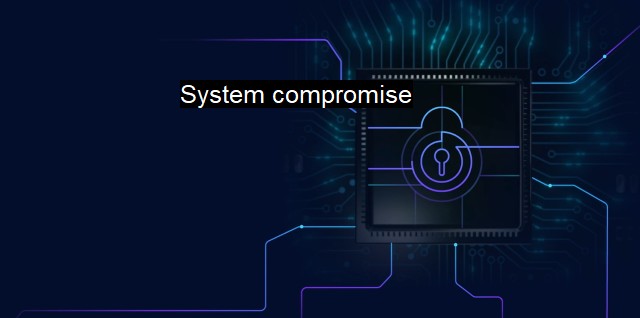What is System compromise?
The Perils of System Compromise: A Comprehensive Look into Cybersecurity Threats and Mitigation sparked by a Malicious Network Hack
System compromise, in the context of cybersecurity and antivirus software, refers to any incident whereby an unauthorized entity gains access to an information system with the ability to alter, steal, delete, or in any way control or manipulate proprietary data and information. Synonymous with system breach or intrusion, this cybersecurity issue represents a pervasive threat in today's digital world. Its technological counterpart, biological viruses, are alarming in their complexity and evasive nature. Similar to how antivirus systems shield biological entities from harmful diseases, cybersecurity strategies defend digital systems from malicious actors seeking unauthorized system entry.Delving deeply into the concept of system compromise, it is crucial to understand its multifaceted avatar in an increasingly connected digital landscape. It's often picturing as a hacker compromising a system to obtain private data, yet system compromise can also refer to undesirable alterations in system integrity induced by malicious software (malware). This malware can cause havoc on a system, leading to corruption or loss of data, siphoning off personal information to third parties, or forcing the system into running detrimental operations, allowing malicious actors remote system control.
How does a system compromise occur? A system compromise can happen in numerous ways. The common themes are vulnerabilities within the system itself or the behaviors of its users. For instance, cybercriminals typically exploit security gaps within outdated software or poorly configured security settings to infiltrate systems. Complex fraudulent schemes such as phishing scams trick users into voluntarily divulging credentials, thereby granting easy access to hackers.
Inherent flaws in an operating system or software architecture are often manipulated by hackers launching zero-day scripted attacks. These system nemeses wait patiently for system updates before obsolete yet unclosed security gaps are exploitable. Social engineering attacks trick users into bypassing their system's defenses, rendering it exceptionally vulnerable. The art of digital deception uses tactics from aggressive persuasion to fake urgency, leading the system compromise.
The breadth of threats emphasizes the importance of antivirus and cybersecurity software, responsible for defending systems from compromise. Antivirus software is essentially a digital immune system, incessantly seeking out and eliminating bugs hoping to make a digital organism their host. By analyzing system activities and internet traffic, these digital guardians will trigger alerts upon detecting anything suspicious.
The signature-based detection technique, for instance, relies on recognizable patterns traced to previously identified malware. Heuristic-based detection, on the other hand, reviews systemic aberrations potentially indicative of a new, unique malware type. The goal of this protective software system is to spot dubious entries via real-time scanning and efficiently eradicate threats to ensure that the integrity and confidentiality of a computer system remain intact.
In the face of rising cyber threat sophistication, modern cybersecurity positions learning algorithms at its forefront. Machine Learning and Artificial Intelligence are progressively encoded in antivirus software. These are due to their competent adaptability to rapid changes in cyber-attack styles and unknown malware, reliably shielding systems from evasion techniques over conventional, solely signature-based detection approaches.
While preventative measures against system compromise are empirical, the elimination of all threats is unrealistic. This limitation necessitates reactive solutions, methodology to limit the consequences of system compromise, including threat isolation, system cleansing, and data recovery.
To summarize, system compromise represents an alerting cybersecurity threat where systems' integrity and confidentiality become felons' playground. Effective and resilient management against it involves comprehensive updates, routine vulnerability checks, user behaviorial education, robust antivirus and cybersecurity systems, and an arsenal of responsive tools. Carefully balanced, these measures construct the first line of defense and last resort salvager against system compromise.

System compromise FAQs
What is a system compromise?
A system compromise occurs when a cyber attacker gains unauthorized access to a computer system and can manipulate it for their own purposes.How can I tell if my system has been compromised?
There are many signs that your system has been compromised, including slow performance, strange pop-ups, unexpected software installations, and changes to system configurations. It's important to run antivirus software to detect any potential threats.What can I do to prevent a system compromise?
To prevent a system compromise, make sure to use strong passwords, regularly update your software and operating system, and be careful when opening emails or clicking on links. Antivirus software can also help identify and remove any potential threats.What should I do if my system has been compromised?
If you suspect that your system has been compromised, immediately disconnect it from the internet and contact your IT department or cybersecurity team. They will be able to assess the situation and take necessary actions to minimize the damage and prevent any further attacks.| | A | | | B | | | C | | | D | | | E | | | F | | | G | | | H | | | I | | | J | | | K | | | L | | | M | |
| | N | | | O | | | P | | | Q | | | R | | | S | | | T | | | U | | | V | | | W | | | X | | | Y | | | Z | |
| | 1 | | | 2 | | | 3 | | | 4 | | | 7 | | | 8 | | |||||||